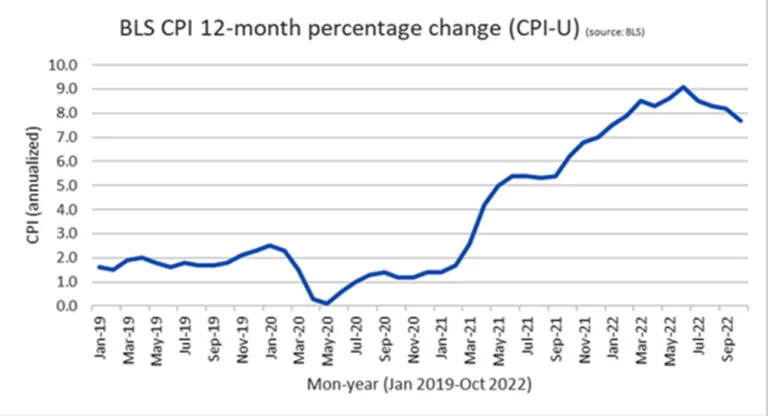By Grant Anderson
February 17, 2023
Moving into 2023, the signs of economic health for the country are increasingly mixed. Every day the markets seem to swing drastically back and forth on the latest news about energy prices, China’s productivity, the Russian war in Ukraine, enduringly high inflation, the debt ceiling, and overall public sentiment about the state of the economy. For short-sellers and day-traders, the pessimism and volatility may be great – but for everyone else, and for our critical aerospace industrial base, these challenges continue to hit very hard.
In fact, digging below the macro-level headlines, the story for many small and medium-sized businesses, including those in high-tech, is one of daily angst and trepidation mixed with increasingly cautious and tempered hope that things will turn around at some point. We are now seeing the ultimate impacts of record-high prices and extended supply chain delivery times taking their toll across the economy, and owners, employers and managers are having to make difficult decisions as a result. It is a set of concerns that is delaying production of critical space and defense program components, pushing schedules to the right, and challenging our readiness and posture. And of course, the toll on human resources from all of this is significant – and major companies, from Amazon to Microsoft are having to execute massive layoffs. More broadly, CEOs are increasingly bearish on the economic outlook for the year.
But there are additional concerns as well. For companies who provide unique capabilities, or deliver sophisticated platforms or components to the Department of Defense, the intelligence community, or NASA, these inflationary pressures and delivery delays are seriously challenging America’s defense industrial base and our future efforts in space.
For many of the items and materials used to design and produce space technology, aircraft or weapons systems, the cost increases are staggering. In fact, the inflation dynamic has really pushed the prices for key raw materials and other components to nearly unworkable highs. Many of the components and source materials used in space and national security platforms are already high, rare, and difficult to access – and the current pressures only magnify what is already pricey. Now however, with inflation as it is, industry is seeing parts and material costs skyrocketing to 100 to 200 percent over normal levels in some cases. Frankly, this is unsustainable in the long run without major adjustment or accommodation. Coupled with the penchant for fixed-price contracting from the large companies and the government, the squeeze could be fatal.

But there is another concerning element at work now as well. For those businesses who perform work for the U.S. government on contracts that are firm, fixed price (where there is little contract flexibility to adjust for these extreme price fluctuations), astronomical inflation has had an especially deleterious effect. Many of these contacts were bid and negotiated in a 2-3 percent inflation economy, but now must be performed in an 8 percent inflationary economy, where the actual costs have risen even higher than the more general Consumer Price Index (CPI).
And as prices remain elevated, tough decisions will have to be made. Companies are shedding talent and drastically re-thinking strategy and planning. The relationship between primes and subcontractors and between solutions-providers and the government runs the risk of becoming strained. While federal agencies have recognized these problems and have promulgated guidance to help contractors seek relief, the inflationary squeeze remains tight. And, as we know, the government works in slow motion, but the squeeze is immediate…meaning that any relief may come too slowly to positively impact the industrial base.
Looking over the horizon, the inflationary dynamic will have a lasting and wide-spreading effect, especially if companies in the industrial base who provide unique solutions and platforms face closure or significant downsizing and workforce reductions. Once operations cease or manufacturing lines close, the time it takes to restart operations can be significant depending on scale, work scope and timeline urgency for new work – if the company can survive at all. Additionally, as industries consolidate (which will be accelerated to the detriment of the small and medium companies) competitiveness is reduced, often giving government less choice for the best value need. And, as costs overall remain high, the quest to find materials at lower price points becomes a major challenge and can force elongated delivery times, which further raises costs. It can also complicate readiness and push back policy goals and scheduling.
Some companies may have the bandwidth, cash, and defense-in-depth to absorb these costs, but smaller businesses stuck between the “rock” of inflation and the “hard place” of contract inflexibility have limited room to breathe and adjust. The tough reality of these current inflationary pressures continues to be a seismic problem for small and medium-sized businesses and vendor-suppliers in the defense and aerospace industry – and companies performing on FFP contracts continue to suffer a real squeeze.
Looking ahead to the next several months, as the new 118th Congress digs into a range of policy priorities, real attention should be paid to how the enduring inflationary problems are impacting small and medium-sized businesses who support key government requirements in the areas of space and defense. With their role in authorizing, appropriating, and conducting oversight, the Congress has the responsibility and governing capability to establish more survivable conditions for the private sector to do business, and this issue area should be no exception. As we look to both continue our expansion in space and to rebuild our defense infrastructure to address a growing set of security threats, finding ways to establish immediate inflationary relief for small and medium-sized businesses on U.S. government contracts should remain a top priority.
Article courtesy of SPACENEWS.COM
https://spacenews.com/opinion-inflations-squeeze-on-space-and-national-security-contracts/
